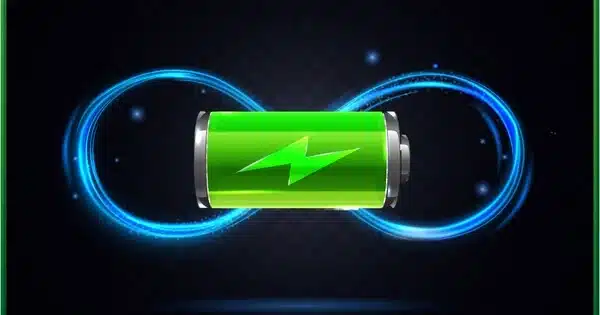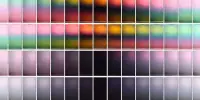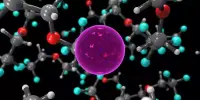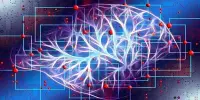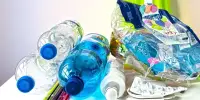Extreme fast charging capability in lithium-ion batteries is an area of active research and development, as it has the potential to greatly enhance the user experience and adoption of electric vehicles (EVs) and portable electronics. However, there are several challenges that must be overcome to enable safe and efficient fast charging.
Lithium-ion batteries dominate the energy storage device market and are the preferred battery for the electric vehicle industry. Improving battery performance is a constant impetus for current battery research. To that end, a team of scientists created a lithium borate-type aqueous polyelectrolyte binder for graphite anodes. In comparison to conventional batteries, their new binder improved Li-ion diffusion and reduced impedance.
Today’s society is rapidly shifting away from fossil fuels and toward renewable energy and electric batteries. Despite the pressing need to transition to greener methods, fundamental issues of efficiency and sustainability remain obstacles to overcome. For example, slow charging speeds are impeding mass market adoption of lithium-ion (Li-ion) batteries for use in electric vehicles. The “holy grail” of battery features that the automobile industry seeks are “extreme” fast charging (where 80% of the battery is charged in 10 minutes), high energy density, and cycle life.
To enable fast-charging capability in batteries, researchers have long attempted to improve electrolyte mass transfer and charge transfer in electrodes, with more emphasis on the former than the latter. A study led by Professor Noriyoshi Matsumi of Japan Advanced Institute of Science and Technology (JAIST) demonstrates a new approach to facilitating fast charging using a binder material that promotes Li-ion intercalation of active material. The binder material improves the diffusion of desolvated Li ions across the solid electrolyte interface (SEI) and within the anode material, resulting in high conductivity, low impedance, and good stability.
Our current strategy of using a bio-derived lithium borate polymer as aqueous polyelectrolyte binder to enhance charge transfer within electrodes such as graphite anodes exhibits fast charging capability.
Prof. Matsumi
The team comprised Former Senior Lecturer Rajashekar Badam, Postdoctoral Research Fellow Anusha Pradhan, Former Graduate Student Ryoya Miyairi, and Doctoral Course Student Noriyuki Takamori from JAIST. Their findings have been published in the journal ACS Materials Letters.
“Our current strategy of using a bio-derived lithium borate polymer as aqueous polyelectrolyte binder to enhance charge transfer within electrodes such as graphite anodes exhibits fast charging capability,” state corresponding authors Profs. Matsumi and Badam of JAIST.
While most battery research is focused on the design of active materials and improved electrolyte mass transfer, the current study takes a different approach by designing a specific binder material that promotes lithium-ion intercalation of the active material. “The binder material contains lithium borate, which improves lithium-ion diffusion in the anode matrices. Furthermore, when compared to conventional battery cells, this binder can form an organoboron SEI with very low interfacial resistance” Prof. Matsumi explains.
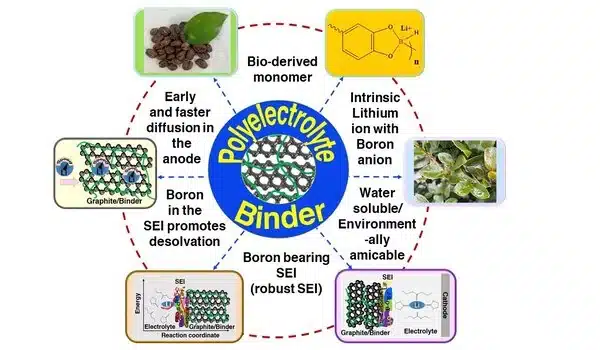
Boron compounds (such as the tetracordinate boron in the binder and the boron-rich SEI) aid in the desolvation of Li+ ions by lowering the activation energy of desolvation of Li+ from the solvent sheath at the SEI. Furthermore, with high diffusion and low impedance, the overpotential associated with charge transfer at the interface is reduced. “This is one of the important determining factors for extreme fast charging,” explains Dr. Anusha Pradhan of JAIST, the paper’s first author.
Li plating occurs on graphite electrodes when charging exceeds the rate of intercalation. It is an unwanted process that reduces battery life and limits fast charging capability. In this study, improved ion diffusion across the SEI and within the electrodes limits the concentration polarization of Li+ ions, resulting in the absence of graphite plating.
The researchers not only present a novel strategy for extremely high-rate chargeable batteries with reduced interfacial resistance in their study, but they also used a biopolymer derived from caffeic acid. Caffeic acid, a plant-based organic compound, is a sustainable and environmentally safe source of material. As a result, while the market for these batteries expands rapidly, the use of bio-based resources in these batteries reduces carbon-dioxide emissions.
Prof. Matsumi emphasizes the structure’s key capabilities in this study, saying, “In future studies, our binder can also be combined with high-rate chargeable active materials to enable further synergistic effect in enhancing performance.”
With increased research into battery performance, we can expect greener options in the way we use energy, particularly in the transportation sector, in the near future. “People will benefit from electric vehicles and convenient mobile devices thanks to high-rate chargeable battery technology. Because the use of renewable resources will keep products available for a long time, regardless of the availability of fossil resources or the influence of high social situations, “Prof. Matsumi concludes.
